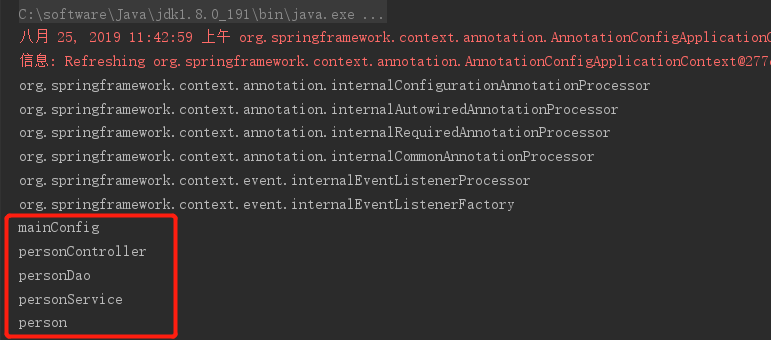Spring注解驱动开发(二)--组件注入
一、前言
上一篇我们搭建了一个简单的Spring项目,并简单的使用了 组件注册。这一篇中,我们来详细的讲解组件注入。
二、组件注入
1. @ComponentScan
在上一篇中,我们使用了@Configuration和@Bean实现了组件注入。但是如果需要注入的组件很多的情况下,每个组件都需要通过一个@Bean注解进行注入,这样就会很麻烦。所以Spring提供了@ComponentScan注解。
@ComponentScan可以指定需要扫描的包,在这些包下,@Component注解标注的组件都会注入到Spring容器中。
注意,@Controller、@Service、@Repository这些注解包含@Component注解的功能。
@Controller public class PersonController { }
@Service public class PersonService { }
@Repository public class PersonDao { }
@ComponentScan(basePackages = "indi.zqc") @Configuration public class MainConfig { @Bean(name = "person") public Person person() { return new Person("张三", 13); } }
public class MainConfigTest { @Test public void test() { ApplicationContext applicationContext = new AnnotationConfigApplicationContext(MainConfig.class); // 获取容器中的所有Bean描述 String[] beanDefinitionNames = applicationContext.getBeanDefinitionNames(); for (String name : beanDefinitionNames) { System.out.println(name); } } }

2. 自定义TypeFilter
在使用@ComponentScan注解时,会将扫描包下所有@Component标注的组件都注入到Spring容器中。但有时候我们不需要注入某个或某些组件,可能你会想把@Component注解去掉就好了。但有这么个场景,如果你想注入的包是第三方的包,这时你就不能修改第三方包中的代码。@ComponentScan注解有一个excludeFilters属性可以排除组件。如下图中,将PersonController排除在外。
@ComponentScan(basePackages = "indi.zqc", excludeFilters = { @ComponentScan.Filter(type = FilterType.ASSIGNABLE_TYPE, classes = PersonController.class) }) @Configuration public class MainConfig { @Bean(name = "person") public Person person() { return new Person("张三", 13); } }

@ComponentScan.Filter的类型有多种
- FilterType.ANNOTATION 通过注解匹配,配合参数classes指定注解类型
- FilterType.ASSIGNABLE_TYPE 通过类匹配,配合参数classes指定类类型
- FilterType.ASPECTJ 通过AspectJ类型的表达式匹配,配合参数pattern指定表达式
- FilterType.REGEX 通过正则表达式匹配类名,配合参数pattern指定表达式
- FilterType.CUSTOM 通过自定义,配合参数classes指定类,自定义类需要实现接口org.springframework.core.type.filter.TypeFilter
可以通过属性excludeFilters将指定的组件排除在外,当然也可以通过includeFilters导入指定的组件。
注意我们先通过userDefaultFilters=false关闭了@CompenentScan默认的功能。然后通过属性includeFilters导入了指定的组件。
@ComponentScan(basePackages = "indi.zqc", includeFilters = { @ComponentScan.Filter(type = FilterType.ASSIGNABLE_TYPE, classes = PersonController.class) }, useDefaultFilters = false) @Configuration public class MainConfig { @Bean(name = "person") public Person person() { return new Person("张三", 13); } }

3. @Scope
@Scope的类型有4种
- singleton singleton的Bean若未标注@Lazy注解,则会在容器刷新时创建
- prototype prototype的Bean会在每次使用时创建
- request request的Bean在同一次请求中共享
- session session的Bean在同一个Session中共享
若Bean是无状态的,比如常用的UserController,UserService等,只负责方法调用,建议singleton,可以减少资源消耗
若Bean是有状态的,怕出现多线程的问题,可以使用prototype
4. @Lazy
@Lazy注解只作用于singleton的Bean,默认singleton的Bean会在容器刷新时创建,若标注该注解,则会在第一次使用时创建




 浙公网安备 33010602011771号
浙公网安备 33010602011771号